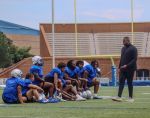Antonio Brown: Talent, Turmoil & What Comes After The Spotlight
Antonio Brown’s Fall From Grace: Talent, Turmoil & What Comes After The Spotlight

Earlier this week, Antonio Brown was extradited from Dubai to the United States, where he now faces a second-degree attempted murder charge stemming from a May 16th shooting outside a celebrity boxing event in Miami. The arrest warrant alleges that Brown grabbed a handgun from a security staffer and fired two shots at a man with whom he had earlier fought, one of which grazed the victim’s neck. For someone whose public identity was once rooted in dazzling on-field athleticism, this incident serves as a jarring pivot into the most serious chapter yet of his legal and personal unraveling.
Antonio Brown’s NFL legacy
Brown’s legacy began with one of the most electrifying runs at wide receiver in recent memory. With the Pittsburgh Steelers, he posted six consecutive 100-catch seasons and became a four-time First-Team All-Pro during the peak of the “Killer B’s” era. But the curtain started to come down when he was traded to the Oakland Raiders in 2019 and never played a regular-season snap. Frostbite, helmet disputes, and off-field antics overshadowed his training camp. A brief stint with the New England Patriots ended after one game amid legal turmoil. He then landed with the Tampa Bay Buccaneers, helped them win Super Bowl LV, but exited in spectacular fashion. In Week 17 of the 2021 season, Brown removed his jersey, shoulder pads, and gloves and walked off the field mid-game, leading Coach Bruce Arians to declare, “He is no longer a Buc.” It’s a career arc of brilliance cut short and overshadowed by self-inflicted derailments.
Legal Battles & Public Behavior
Beyond the attempted murder charge, Brown’s post-career chapters feature a pattern of legal entanglements and behavioral red flags. He’s faced battery and domestic violence allegations, child-support warrants, lawsuits, and bankruptcy. His social media posts have featured rage and erratic declarations, including references to diagnosing himself with Chronic Traumatic Encephalopathy (CTE) and attributing his actions to brain trauma. With each new incident, the public face of his talent has been increasingly eclipsed by the image of someone spiraling out of control. His actions have raised questions about how much of this is self-destruction, how much is mental-health related, and how much is the lasting cost of repeated physical trauma.
Talent vs. Turmoil
At its heart, AB’s story is a study in extremes. On one hand, there’s route-running mastery, explosive speed, unmatched production, and a compelling underdog origin story. On the other hand, there are unrelenting distractions, fraught relationships with teams, escalating legal issues, and behavior inconsistent with his talent. The tension between greatness and self-sabotage has defied his journey. Add to that the mounting conversations about CTE, head trauma, mental-health challenges, and the long shadows they cast over athletes who push their bodies to the limit, and you find a narrative far more complex than “talent wasted.” Whether Brown is a victim of circumstances or the architect of his own downfall (or both) is now part of the larger cultural conversation around sports, brain health, and accountability.
What will we remember about AB?
So what will we remember about Antonio Brown? Will it be the plays, the catches, the raw athletic brilliance he showcased with the Steelers and the Buccaneers? Or will it be the meltdowns, the missed opportunities, the off-field chaos? Most likely, we’ll remember somewhere in between. His peak was undeniably elite, but his fall has been equally unmistakable. Only time will tell whether the legal chapter becomes a footnote or a defining culmination. In the end, Brown’s legacy may serve as both a warning and a lesson that talent alone isn’t always enough…and that the human costs of high performance and unchecked behavior can ripple long after the stadium lights dim.
RELATED: Brooklyn Legend: The Rise & Fall Of Sebastian Telfair







